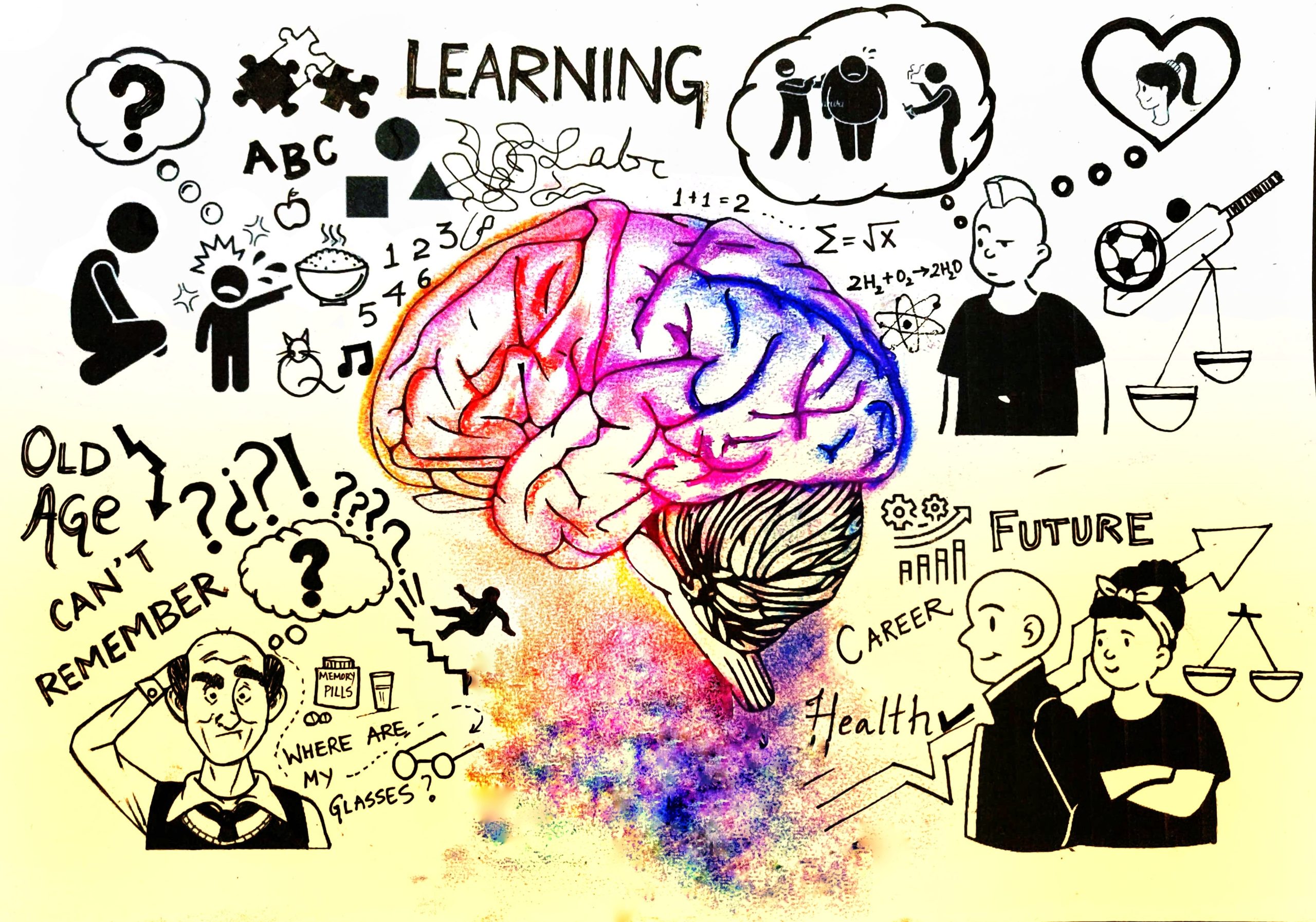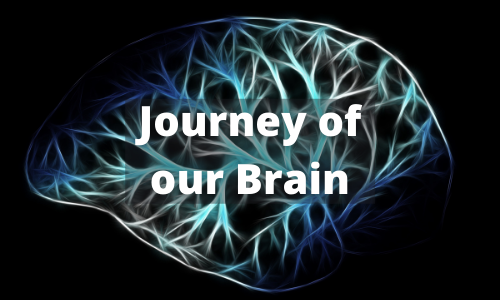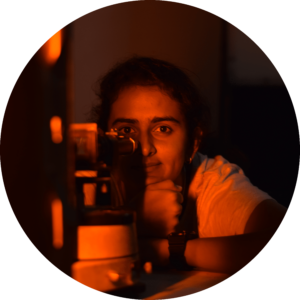The Human Brain is the master of our actions and reactions. Every act we perform that gives us the identity of Homo sapiens, the most superior of all species on Earth, is governed by none other than this highly convoluted organ sitting on the apex of the human body. We have had an intriguing journey through various realms of neuroscience, and the brain has left us overwhelmingly amazed by its functioning and complexity. Here, I present the journey of the human brain- right from inside a fetus to a person’s death.

The Mastermind is born!
The nervous system is formed from the outermost germ layer: the ectoderm. The brain development commences about two weeks after gestation and continues till the early years of adulthood.
It begins with neural plate formation. This plate folds into itself, forming a neural tube. It is divided into three distinct regions: Forebrain, midbrain, hindbrain along with spinal cord. The neural progenitor cells give rise to the neurons that conduct impulses within the body, and glial cells, which support and nourish the neurons. Neuronal migration is a process in which different classes of nerve cells migrate to specific locations to properly interact with other cells. The brain stem, which controls involuntary processes such as breathing, Blood Pressure and Heart Rate, is developed by the second trimester. The fetus starts to recognize voices and also undergoes sleep cycles. During the third trimester, the distinct large and convoluted shape of the brain is defined.
The genesis isn’t over yet
The brain doesn’t stop modifying itself after an infant is born. It is still dynamic, with many processes that began during gestation, continuing to take place many years after birth. This includes apoptosis of neurons that are not required, changes in the synaptic connections or synaptic pruning, and myelination, which is the development of myelin sheath, a covering around the axon of the neurons.
Babies and toddlers are very curious about everything around them. It is also said that early years of development are crucial for children, where they imbibe whatever they experience in their day-to-day life. It is pivotal in forming the foundation of successive progress in a kid. Babies are tuned to differentiate between any language until six months. After that, their brain gets tuned to their native language, which they usually listen to, due to synaptic connections narrowing down. Babies as young as six months old can differentiate between the faces of two monkeys! This ability also narrows down, making the child able to differentiate between different human faces. Research revealed that children brought up in foster care show a lesser degree of brain development than those living with biological parents. An unsafe home environment can make the child vulnerable to anxiety, depression, aggressive attitude, and other behavioral problems. Children need to be brought up in healthy and safe surroundings to ensure the proper development of their mental health and abilities.
As puberty comes into the picture, cortical areas develop more, with increased synaptic connection, pruning and myelination. This helps in the faster transmission of signals. The prefrontal cortex development helps in higher-order cognitive processes, such as planning and implementing tasks, creativity, etc. Three characteristic behaviors observed among adolescents are the will to try something new or change themselves, increased risk-taking behavior and peer interactions. In young adults, these behavioral patterns seem to diminish. Researchers have seen that teens and adults seem to use the brain through different approaches. Adults tend to mainly use the prefrontal cortex, the brain’s rational part, whereas teenagers mainly work out situations through the amygdala, the emotional part of the brain. Unlike adolescents, adults deal with situations practically, thinking about the long-term consequences. During adolescence, these areas aren’t completely developed. Much of the Brain is not completely constructed until about 25 years of age.
The ageing brain
With age, most of the changes aren’t progressive. As the person gets older, there is a reduction in brain volume, grey matter and white matter are affected, and neuronal cell death occurs. Ageing leads to several changes in the person’s activity, the most common being the loss of memory. There is a reduction in the levels of neurotransmitters such as dopamine and serotonin and Brain-Derived Neurotropic Factors, which can affect cognitive and motor function, reduce synaptic plasticity, and formation of new neurons. Levels of Reactive Oxygen Species rise, and there can be chances of dementia and stroke. Healthy diet, mediation and exercise have been proven to be beneficial for brain functioning and to prevent these issues.
After we die…
Death implies that the heart has stopped pumping blood, eventually reducing oxygen supply. The brain cells are also deprived of oxygen and eventually start to degenerate. However, scientists have recorded that in rats, sensory awareness and consciousness are completely lost seconds after decapitation, whereas neurons remain active for up to minutes, displaying gradual loss of electrical activity. Studies in humans displayed loss of brain activity shortly before death. One surprising finding was of a person who showed brain activity minutes after clinical death was announced, about which scientists have no proper explanation. Researchers have also put up Near-Death Experiences encountered by people who were revived to life after cardiac arrests, such as a light at the end of the tunnel, the person leaving his/her body, etc. However, phenomena like these are still a paradox.
In this way, the brain goes through an incredibly long and adventurous journey with lots of ups and downs. It changes, encounters something new and adapts yet again. It keeps moving from one version of itself to another to keep us on the move. The brain has never failed to astonish us by the way it works and will keep surprising us when we dig more and more into its secrets!
References:
Adolescent Maturity and the Brain: The Promise and Pitfalls of Neuroscience Research in Adolescent Health Policy. (2009, September 1). PubMed Central (PMC). https://www.ncbi.nlm.nih.gov/pmc/articles/PMC2892678/
Ageing and the Brain. (2006, February 1). PubMed Central (PMC). https://www.ncbi.nlm.nih.gov/pmc/articles/PMC2596698/
Brain Development and the Role of Experience in the Early Years. (2009, November 1). PubMed Central (PMC). https://www.ncbi.nlm.nih.gov/pmc/articles/PMC3722610/
Dockrill, P. (n.d.). Here’s What Happens to Your Brain When You Die. ScienceAlert. https://www.sciencealert.com/here-s-what-happens-to-brain-when-die-consciousness-death
Does Your Brain Know When Youâre Dead? (2017, November 8). WebMD. https://www.webmd.com/brain/news/20171108/does-your-brain-know-when-youre-dead
Herschkowitz, N. (1988). Brain Development in the Fetus, Neonate and Infant. Neonatology, 54(1), 1–19. https://doi.org/10.1159/000242818
National Research Council (US) and Institute of Medicine (US) Committee on Integrating the Science of Early Childhood Development. (2000). The Developing Brain – From Neurons to Neighborhoods – NCBI Bookshelf. NCBI. https://www.ncbi.nlm.nih.gov/books/NBK225562/
Shabir, O., PhD. (2019, September 23). What Happens to the Brain After Death? News-Medical.Net. https://www.news-medical.net/health/What-Happens-to-the-Brain-After-Death.aspx
Understanding the Teen Brain – Health Encyclopedia – University of Rochester Medical Center. (n.d.). University of Rochester Medical Center. Retrieved August 23, 2021, from https://www.urmc.rochester.edu/encyclopedia/content.aspx?ContentTypeID=1&ContentID=3051
. . .
Writer

Sreelakshmi S Kumar
Sreelakshmi is pursuing her undergraduate course degree in Zoology from Fergusson College, Pune. The field of Immunology and Virology interests her the most. She harbours her love for science and teaching inside her, and she wishes to teach in the future. Dancing, reading and calligraphy are some of her leisure activities and she is a big foodie too!
Illustrator
Aishwarya Girish
Aishwarya is an undergraduate pursuing her degree in B.E Biotechnology from Ramaiah Institute of Technology.


